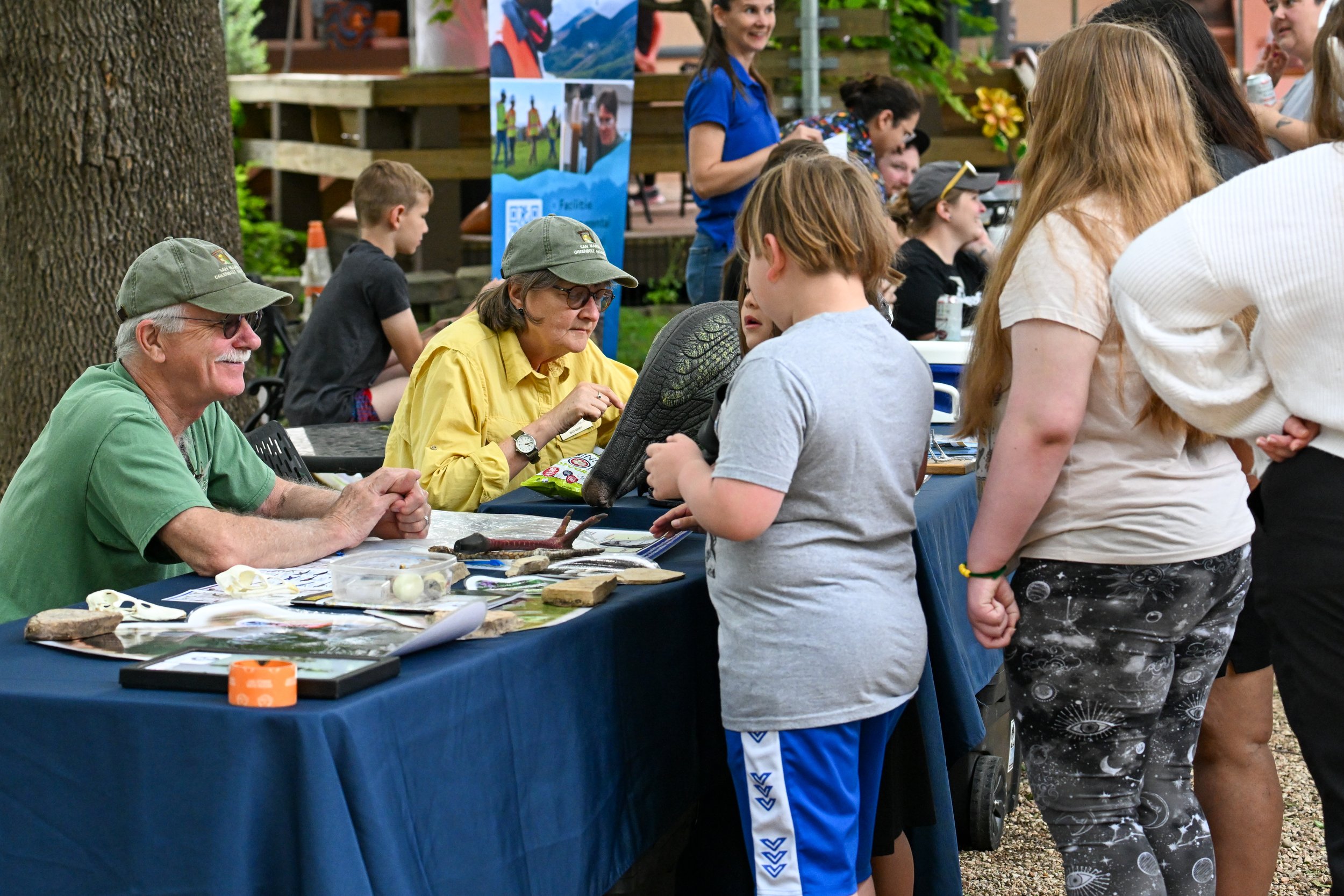Migratory Bird Festival 2024
San Marcos Discovery Center
May 11, 2024
“Where birds thrive, people prosper.”
—Chloe Crumley, Audubon Texas Engagement Manager
Sharon Moore and Betsy Cross
The San Marcos Discovery Center hosted their Migratory Bird Day Festival on May 11, 2024 in San Marcos, Texas.
Discovery Center staff along with volunteers from Hays County Master Naturalist, the San Marcos Greenbelt Alliance, Texas Parks and Wildlife, the San Marcos River Foundation, and many others were onsite to raise awareness about the importance of science-based conservation initiatives for birds and to educate visitors and inspire new bird enthusiasts.
The theme of this year’s World Migratory Bird Day focused on the importance of insects to migratory birds.
HCMN Jo Korthals teaching children at the Hays County Master Naturalist exhibit table. Photo: courtesy Betsy Cross
HCMN Jo Korthals and Discovery Center Specialist Niki Lake Photo: courtesy Betsy Cross
HCMN exhibit table Photo: courtesy Sharon Moore
HCMN exhibit table Photo: courtesy Sharon Moore
The San Marcos River Foundation exhibit table Photo: courtesy Betsy Cross
The San Marcos River Foundation exhibit table Photo: courtesy Betsy Cross
Texas Parks and Wildlife exhibit table Photo: courtesy Betsy Cross
Texas Parks and Wildlife exhibit table Photo: courtesy Betsy Cross
Making homes for mason bees was one of the kid projects at the craft table. It was a good way to teach kids about pollinators. Photo: courtesy Sharon Moore
Mason bees are solitary bees. They are slightly smaller than domestic honeybees and are metallic blue or blue-black in color. They don’t make honey or beeswax. They are important pollinators and are considered docile. Here are some interesting facts about mason bees:
Just two or three females can pollinate a mature apple tree!
In the wild, mason bees lay their eggs in small natural cavities such as woodpecker holes, insect holes, and hollow stems. But they will also lay their eggs in artificial nesting cavities, such as wooden blocks with holes drilled in them, cardboard tubes, and paper straws. Because mason bees are unable to excavate their own nesting cavities, they seem to be quite happy to use whatever location is suitable.
To avoid pest and disease problems, artificial nesting boxes should be carefully cleaned or disposed of after one or two seasons of use. https://www.gardeners.com/how-to/about-mason-bees/8198.html
Art Corner table Photo: courtesy Sharon Moore
Golden-cheeked Warbler watercolor by San Marcos High School student Tristan Photo: courtesy Sharon Moore
Photo: courtesy Sharon Moore
Photo: courtesy Betsy Cross
Photo: courtesy Sharon Moore
Nicole Marshall (in the blue shirt) led the bird walks. Participants in each of the two groups shown here spotted a white-eyed vireo. One group saw the vireo with a big, juicy green caterpillar in its bill. The other group saw a Wilson’s warbler, one of the many warblers that migrate through Central Texas this time of year. Other birds, including painted buntings, Carolina wrens, and a yellow-billed cuckoo, were identified by their songs and calls.
Wildlife handler Brook presented Durango, the Eurasian Eagle Owl, to the audience. Photo: courtesy Betsy Cross
Durango—they call him Rango for short—was a favorite with kids and adults alike. Rango is nine years old. He can't be returned to the wild because he was raised in captivity and imprinted on humans as a fledgling. In captivity, he can live as long as 40 years. His life span would be about half that in the wild. His huge eyes help him see in low light, and he can turn his head 270 degrees. The kids really loved that. Brook asked the audience if they thought owls were smart, and if not, what they thought was the smartest raptor. Turns out that owls are not the smartest. Owls got that reputation because they’re associated with the Greek goddess Athena, who was among other things, the goddess of wisdom. It's the Harris’s Hawk that is the smartest raptor. Brook also talked about Rango's feathers, their shape, and how this allows owls to fly silently. One man remarked that his feathers resemble tree bark, making him easily camouflaged in his natural habitat. Eurasian Eagle Owls are native to Europe and Asia.
Photo: courtesy Sharon Moore
Photo: courtesy Sharon Moore
Scavenger hunt game Photo: courtesy Sharon Moore
Scavenger hunt game Photo: courtesy Sharon Moore
Scavenger hunt game Photo: courtesy Sharon Moore
San Marcos Greenbelt Alliance volunteers discuss plans for a new trail in the Purgatory Creek Natural Area. Photo: courtesy Sharon Moore
The game was Which Nest Is Best?—owl or eagle? Photo: courtesy Sharon Moore
Photo: courtesy Sharon Moore
Photo: courtesy Betsy Cross
Photo: courtesy Betsy Cross
Protecting insects and birds
Visit the website of the World Migratory Bird Day in the Americas to find resources such as the flyer below and additional information about protecting birds and insects.


























